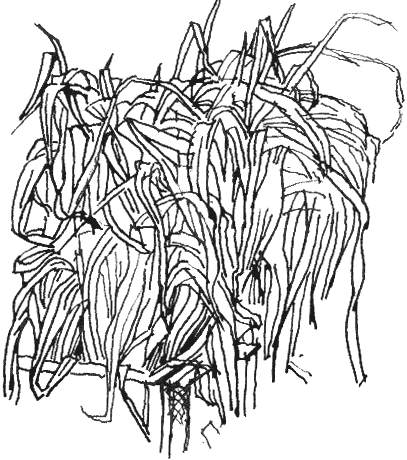|   4.45
p.m. After a busy day in the studio, I've walked down the newly wood-chipped
garden path to our now sparkling greenhouse to do a drawing before the
light fades. The days are getting noticably longer. 4.45
p.m. After a busy day in the studio, I've walked down the newly wood-chipped
garden path to our now sparkling greenhouse to do a drawing before the
light fades. The days are getting noticably longer.
Using my largest bamboo pen, I draw these leeks in a
deep bed next to the greenhouse. I planted them from seed last spring;
half of the plants in that four foot row filled the space I had available
last summer and I never got around to planting out the rest of them.  Perhaps
I could plant them out now, for harvesting in late spring/early summer. Perhaps
I could plant them out now, for harvesting in late spring/early summer.
There's a soft cawing of a crow, the bright trill of
a dunnock and the stuttered alarm of a blackbird
getting ready to roost. There's a birdwatcher's mnemonic for the drowsily
 insistent
repeated five-note cooing of a wood pigeon ('coo-coooo-coo,
coo coo'); something along the lines of 'I don't like cook-ing') insistent
repeated five-note cooing of a wood pigeon ('coo-coooo-coo,
coo coo'); something along the lines of 'I don't like cook-ing')
| |
Re the leeks...dont bother transplanting them
as they are biennial and will just start to send up a flowering
shoot. They wont be worth eating but the resulting flowers and seed
heads are worth having as they are like golf balls and you would
enjoy sketching them.
Best advice then is to transplant some for reasons above and eat
the rest before they start to shoot.
My thanks to Tom Walsh; I might try planting a
few in the flower border.  |
|
Richard Bell, richard@willowisland.co.uk
|